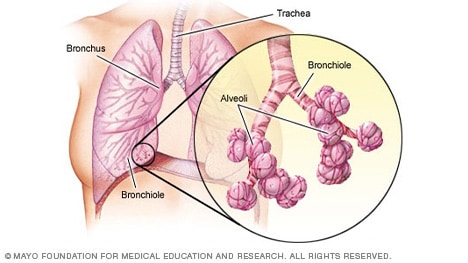Overview
Acute respiratory distress syndrome (ARDS) occurs when fluid builds up in the tiny, elastic air sacs (alveoli) in your lungs. The fluid keeps your lungs from filling with enough air, which means less oxygen reaches your bloodstream. This deprives your organs of the oxygen they need to function.
ARDS typically occurs in people who are already critically ill or who have significant injuries. Severe shortness of breath — the main symptom of ARDS — usually develops within a few hours to a few days after the precipitating injury or infection.
Many people who develop ARDS don't survive. The risk of death increases with age and severity of illness. Of the people who do survive ARDS, some recover completely while others experience lasting damage to their lungs.
Products & Services
Symptoms
The signs and symptoms of ARDS can vary in intensity, depending on its cause and severity, as well as the presence of underlying heart or lung disease. They include:
- Severe shortness of breath
- Labored and unusually rapid breathing
- Low blood pressure
- Confusion and extreme tiredness
When to see a doctor
ARDS usually follows a major illness or injury, and most people who are affected are already hospitalized.
Causes
Bronchioles and alveoli

Bronchioles and alveoli
Your bronchioles are some of the smallest airways in your lungs. Inhaled air passes through tiny ducts from the bronchioles into elastic air sacs (alveoli). The alveoli are surrounded by the alveolar-capillary membrane, which normally prevents liquid in the capillaries from entering the air sacs.
The mechanical cause of ARDS is fluid leaked from the smallest blood vessels in the lungs into the tiny air sacs where blood is oxygenated. Normally, a protective membrane keeps this fluid in the vessels. Severe illness or injury, however, can cause damage to the membrane, leading to the fluid leakage of ARDS.
Underlying causes of ARDS include:
- Sepsis. The most common cause of ARDS is sepsis, a serious and widespread infection of the bloodstream.
- Inhalation of harmful substances. Breathing high concentrations of smoke or chemical fumes can result in ARDS, as can inhaling (aspirating) vomit or near-drowning episodes.
- Severe pneumonia. Severe cases of pneumonia usually affect all five lobes of the lungs.
- Head, chest or other major injury. Accidents, such as falls or car crashes, can directly damage the lungs or the portion of the brain that controls breathing.
- Coronavirus disease 2019 (COVID-19). People who have severe COVID-19 may develop ARDS.
- Others. Pancreatitis (inflammation of the pancreas), massive blood transfusions and burns.
Risk factors
Most people who develop ARDS are already hospitalized for another condition, and many are critically ill. You're especially at risk if you have a widespread infection in your bloodstream (sepsis).
People who have a history of chronic alcoholism are at higher risk of developing ARDS. They're also more likely to die of ARDS.
Complications
If you have ARDS, you can develop other medical problems while in the hospital. The most common problems are:
- Blood clots. Lying still in the hospital while you're on a ventilator can increase your risk of developing blood clots, particularly in the deep veins in your legs. If a clot forms in your leg, a portion of it can break off and travel to one or both of your lungs (pulmonary embolism) — where it blocks blood flow.
- Collapsed lung (pneumothorax). In most ARDS cases, a breathing machine called a ventilator is used to increase oxygen in the body and force fluid out of the lungs. However, the pressure and air volume of the ventilator can force gas to go through a small hole in the very outside of a lung and cause that lung to collapse.
- Infections. Because the ventilator is attached directly to a tube inserted in your windpipe, this makes it much easier for germs to infect and further injure your lungs.
- Scarring (pulmonary fibrosis). Scarring and thickening of the tissue between the air sacs can occur within a few weeks of the onset of ARDS. This stiffens your lungs, making it even more difficult for oxygen to flow from the air sacs into your bloodstream.
Thanks to improved treatments, more people are surviving ARDS. However, many survivors end up with potentially serious and sometimes lasting effects:
- Breathing problems. Many people with ARDS recover most of their lung function within several months to two years, but others may have breathing problems for the rest of their lives. Even people who do well usually have shortness of breath and fatigue and may need supplemental oxygen at home for a few months.
- Depression. Most ARDS survivors also report going through a period of depression, which is treatable.
- Problems with memory and thinking clearly. Sedatives and low levels of oxygen in the blood can lead to memory loss and cognitive problems after ARDS. In some cases, the effects may lessen over time, but in others, the damage may be permanent.
- Tiredness and muscle weakness. Being in the hospital and on a ventilator can cause your muscles to weaken. You also may feel very tired following treatment.
Aug. 03, 2022